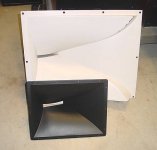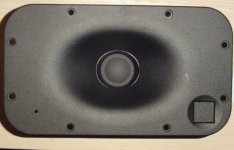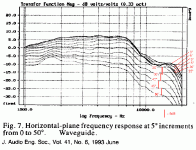markus76 said:
I don't know.
Digged deeper and found that trading curves change with level (Blauert "Spatial Hearing"). Furthermore Blauert reports that in trading experiments multiple sound sources were perceived. Looks like there is no single number that describes interaction of interchannel level difference and interchannel time difference.
Best, Markus
Markus
I think that the point is that going in one direction is a significant improvement and going in the other a significant degradation. The exact "trade-off" values are kind of immaterial since you don't have that much control. Just do what improves things (toe-in CD loudspeakers) and let it go at that.
gedlee said:I think that the point is that going in one direction is a significant improvement and going in the other a significant degradation.
I wish it was that simple. Not toeing in the speaker results in lower crosstalk between ears. Things improved for me when I toed in only 15°. Maybe that's just due to my listening position which is only 1.5 ft. from the back wall. Walls to the left and the right provide strong contralateral reflections.
Best, Markus
markus76 said:
I don't know.
Digged deeper and found that trading curves change with level (Blauert "Spatial Hearing"). Furthermore Blauert reports that in trading experiments multiple sound sources were perceived. Looks like there is no single number that describes interaction of interchannel level difference and interchannel time difference.
Best, Markus
No, think this through. It must be done with headphones. If it was in an anechoic chamber, then the delta level and delta time difference can not be independently manipulated.
The multiple image issue only comes into play when the cues of delta level and delta time are grossly mismatched (in terms of which ear is "favored" and by "how much"). At more reasonable values, there will be single image that is well-lateralized and not diffuse.
In the literature, the "trade is usually defined in terms of usec per dB. That is how large of a delta time is required to "re-center" an image that has been shifted by an imposition of a delta level.
I would not get too caught up in the specific value of the trading ratio since the answer "depends ...."
WithTarragon said:No, think this through. It must be done with headphones. If it was in an anechoic chamber, then the delta level and delta time difference can not be independently manipulated.
Why not? For example: Start with a signal that is played back by both speakers. Delay is 0 and level of both signals is the same. You'll hear a phantom center. Now raise the level of the left speaker. The phantom source shifts to the left. Now you delay the left channel until the phantom source shifts back to the center. That's how trading experiments were conducted.
There is a big difference if tests were conducted with headphones or loudspeakers because of crosstalk. Here are values found by Eberhard Sengpiel for loudspeaker playback:
Interchannel level differences:
An externally hosted image should be here but it was not working when we last tested it.
Interchannel time differences:
An externally hosted image should be here but it was not working when we last tested it.
Best, Markus
You have me confused. I thought you referring to the interaural time-intensity trading ratio. That is something quite a bit different than what you are depicting.
However, if you went through and looked at a Lissajous of what you are depicting, you might be surprised.
However, if you went through and looked at a Lissajous of what you are depicting, you might be surprised.
"Trading" and "Equivalence" ARE different things. "Trading" describes what compensation in time or level is necessary to move a phantom source back to its initial location. "Equivalence" describes what interchannel level or time differences are needed to place a phantom source at a specific direction of the sound stage.
Best, Markus
Best, Markus
In chronological order:
http://www.xlrtechs.com/dbkeele.com...rint) - Horn Covers Flat Rectangular Area.pdf
http://www.jblpro.com/pub/obsolete/4660.pdf
http://www.audioheritage.org/vbulletin/showthread.php?t=5671
http://www.audioheritage.org/vbulletin/showthread.php?t=8373
http://www.audioheritage.org/vbulletin/showpost.php?p=112522&postcount=52
http://www.diyaudio.com/forums/showthread.php?postid=1842710#post1842710
http://www.xlrtechs.com/dbkeele.com...rint) - Horn Covers Flat Rectangular Area.pdf
http://www.jblpro.com/pub/obsolete/4660.pdf
http://www.audioheritage.org/vbulletin/showthread.php?t=5671
http://www.audioheritage.org/vbulletin/showthread.php?t=8373
http://www.audioheritage.org/vbulletin/showpost.php?p=112522&postcount=52
http://www.diyaudio.com/forums/showthread.php?postid=1842710#post1842710
Attachments
Patrick Bateman said:
The third link is required reading for everyone on this thread
Although the idea is great, Eargle doesn't reference any literature. Psychoacoustic data (see Blauert "Spatial Hearing" for further references) suggests that trading is signal and level dependent. Furthermore stereo recordings use interchannel level and time differences in different degrees. No single number for "over-correction" as Eargle calls it will account for that. It might make things even worse because there's more crosstalk.
Best, Markus
Markus, I recognize you like to sengpiel a lot just like I do. 😉
@all: "to sengpiel" (copyright by me 🙂) is like "to google", just for microphone/recording/etc stuff. Eberhard Sengpiel is one of the sharpest guys around in these matter (professional audio engineer and professor, too). It's a real pity that he publishes his 500+ single-page PDFs and other stuff only in german. For those who read german, go there: http://www.sengpielaudio.com/ (the organization of is site is a bit messy, though. Hence I've downloaded all his stuff, sorted it and made sort of a "master handbook" out of it. Was well worth the pain).
- Klaus
@all: "to sengpiel" (copyright by me 🙂) is like "to google", just for microphone/recording/etc stuff. Eberhard Sengpiel is one of the sharpest guys around in these matter (professional audio engineer and professor, too). It's a real pity that he publishes his 500+ single-page PDFs and other stuff only in german. For those who read german, go there: http://www.sengpielaudio.com/ (the organization of is site is a bit messy, though. Hence I've downloaded all his stuff, sorted it and made sort of a "master handbook" out of it. Was well worth the pain).
- Klaus
gedlee said:
In the early 90's, thanks to John Eargle, JBL paid for me to file a patent on my OS work. However, a glitch in the works prevented it from issuing and it was abandoned, which is why the OS waveguide is in the public domain. I did not work directly with JBL at the time, but there is little doubt that the concepts in my work and the patent application were reviewed at JBL and utilized in their work. It would have been necessary for them to work independently of me for the simple reason that it was all my work. Had I worked with them and we came up with something, they would not have been able to patent it very easily. This is one reason why corporations hold consultants at arms length.
How long after was it that JBL first built EOS (Elliptical Oblate Spheroid) waveguides into product?
I don't have any LSRs to measure and see if there's a notch in the on-axis response, but perhaps some other member here does. In theory, should it be there with a dome as the source?
Someone asked earlier how come the Big Boys aren't using OS, if it's so good. It's not NIH syndrome, clearly, and it's not because they're stupid. I suspect JBL sim'd and proto'd every variant that might have had potential application for their use, and therein may lie the answer: it's gotta work on-axis, or it's not even up for consideration. It may be on the basis of that determination they decided it was not worth pursuing protection for the design.
In any case, I have a couple of JBL waveguides that appear to be OS coming in here, and if they perform well, I'll send them on to you for evaluation, along with my rationale as to why you might do so....
Someone asked earlier how come the Big Boys aren't using OS, if it's so good. It's not NIH syndrome, clearly, and it's not because they're stupid. I suspect JBL sim'd and proto'd every variant that might have had potential application for their use, and therein may lie the answer: it's gotta work on-axis, or it's not even up for consideration. It may be on the basis of that determination they decided it was not worth pursuing protection for the design.
In any case, I have a couple of JBL waveguides that appear to be OS coming in here, and if they perform well, I'll send them on to you for evaluation, along with my rationale as to why you might do so....
"I don't have any LSRs to measure and see if there's a notch in the on-axis response, but perhaps some other member here does. In theory, should it be there with a dome as the source?"
Hello Zilch
I have a pair of the waveguides and 053ti tweeters. There is no notch in the JBL measurements. I didn't see any in a quick measurement I took either. They are elliptical. I thought Earls notch was due to the waveguides being symmetrical?
Rob🙂
http://www.jblpro.com/pub/recording/lsr28p.pdf
Hello Zilch
I have a pair of the waveguides and 053ti tweeters. There is no notch in the JBL measurements. I didn't see any in a quick measurement I took either. They are elliptical. I thought Earls notch was due to the waveguides being symmetrical?
Rob🙂
http://www.jblpro.com/pub/recording/lsr28p.pdf
Attachments
Robh3606 said:
I have a pair of the waveguides and 053ti tweeters. There is no notch in the JBL measurements. I didn't see any in a quick measurement I took either. They are elliptical. I thought Earls notch was due to the waveguides being symmetrical?
Yes, there seems to be some confusion on this issue.
gedlee said:
The ESP12 has the axial hole that is inevitable with an axi-symmetric device. This is the price one must pay for a polar response that is truly CD in all planes. An elliptical waveguide would not have the axial hole.
The 1993 Geddes elliptical has an axial notch, shallower, at a higher frequency, but clearly present (below).
gedlee said:
But an elliptical mouth will make the dip benign. It actually doesn't go away, it just broadens and becomes very shallow with eccentricity. It case you didn't see it, I posted a picture of a CNC'd elliptical mold awaiting completion (somewhere, don't rememebr). No promises on timing, but I am going to look at it.
Perhaps he will find a way to eliminate it.
Attachments
This will be there unless the expansion of the latter 3/4 of the expansion is changed. Basically, the longer the nearly straight part is, the lower this dip seems to occur. I wonder what size this wave guide was. My guess would be half the size it is on the Summas.ZilchLab said:
Yes, there seems to be some confusion on this issue.
The 1993 Geddes elliptical has an axial notch, shallower, at a higher frequency, but clearly present (below).
Perhaps he will find a way to eliminate it.
"I wonder what size this wave guide was. My guess would be half the size it is on the Summas."
So are we talking the depth so wavelength dependent as a function of waveguide depth?? When they match we get a dip??
Rob🙂
So are we talking the depth so wavelength dependent as a function of waveguide depth?? When they match we get a dip??
Rob🙂
My small wave guide had a similar dip in that frequency range, but not as deep. Based on my sims of various shapes of similar mouth sizes, this would change.
My elliptical wave guide did not have that kind of dip.
My elliptical wave guide did not have that kind of dip.
soongsc said:
This will be there unless the expansion of the latter 3/4 of the expansion is changed. Basically, the longer the nearly straight part is, the lower this dip seems to occur. I wonder what size this wave guide was. My guess would be half the size it is on the Summas.
http://www.exdreamnet.de/download/WgPractice.zip
We've gone from "hole" to "notch" to "dip."
"Swale," anyone?
[Spin, spin, spin.... 😉 ]
- Status
- Not open for further replies.
- Home
- Loudspeakers
- Multi-Way
- Horn vs. Waveguide


